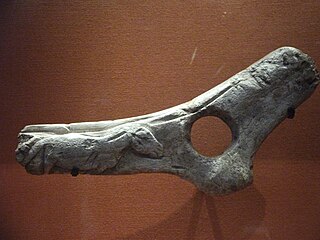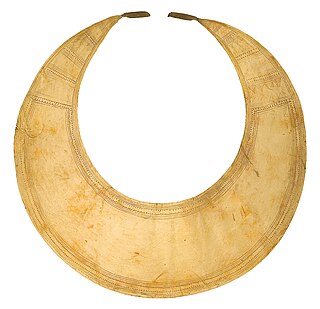
Lascaux is a network of caves near the village of Montignac, in the department of Dordogne in southwestern France. Over 600 parietal wall paintings cover the interior walls and ceilings of the cave. The paintings represent primarily large animals, typical local contemporary fauna that correspond with the fossil record of the Upper Paleolithic in the area. They are the combined effort of many generations. With continued debate, the age of the paintings is now usually estimated at around 17,000 - 22,000 years. Because of the outstanding prehistoric art in the cave, Lascaux was inducted into the UNESCO World Heritage List in 1979, as an element of the Prehistoric Sites and Decorated Caves of the Vézère Valley.

Creswell Crags is an enclosed limestone gorge on the border between Derbyshire and Nottinghamshire, England, near the villages of Creswell and Whitwell. The cliffs in the ravine contain several caves that were occupied during the last ice age, between around 43,000 and 10,000 years ago. Its caves contain the northernmost cave art in Europe. The evidence of occupation found in the rich series of sediments that accumulated over many thousands of years is regarded as internationally unique in demonstrating how prehistoric people managed to live at the extreme northernmost limits of their territory during the Late Pleistocene period.

In the history of art, prehistoric art is all art produced in preliterate, prehistorical cultures beginning somewhere in very late geological history, and generally continuing until that culture either develops writing or other methods of record-keeping, or makes significant contact with another culture that has, and that makes some record of major historical events. At this point ancient art begins, for the older literate cultures. The end-date for what is covered by the term thus varies greatly between different parts of the world.
Portable art refers to the small examples of Prehistoric art that could be carried from place to place, which is especially characteristic of the Art of the Upper Palaeolithic and Mesolithic eras. Often made of ivory, bone, antlers or stone, these pieces have been found in South Africa all the way up to Eurasia. It is one of the two main categories of Prehistoric art, the other being the immobile Parietal art, effectively synonymous with rock art.
Below are notable events in archaeology that occurred in 1876.

Prehistoric Wales in terms of human settlements covers the period from about 230,000 years ago, the date attributed to the earliest human remains found in what is now Wales, to the year AD 48 when the Roman army began a military campaign against one of the Welsh tribes. Traditionally, historians have believed that successive waves of immigrants brought different cultures into the area, largely replacing the previous inhabitants, with the last wave of immigrants being the Celts. However, studies of population genetics now suggest that this may not be true, and that immigration was on a smaller scale.

The Bontnewydd palaeolithic site, also known in its unmutated form as Pontnewydd, is an archaeological site near St Asaph, Denbighshire, Wales. It is one of only three sites in Britain to have produced fossils of ancient species of humans and the only one with fossils of a classic Neanderthal. It is located a few yards east of the River Elwy, near the hamlet of Bontnewydd, near Cefn Meiriadog, Denbighshire.

The art of the Upper Paleolithic represents the oldest form of prehistoric art. Figurative art is present in Europe and Southeast Asia, beginning around 50,000 years ago. Non-figurative cave paintings, consisting of hand stencils and simple geometric shapes, are somewhat older, at least 40,000 years old, and possibly as old as 64,000 years. This latter estimate is due to a controversial 2018 study based on uranium-thorium dating, which would imply Neanderthal authorship and qualify as art of the Middle Paleolithic.

The Swimming Reindeer is a 13,000-year-old Magdalenian sculpture of two swimming reindeer conserved in the British Museum. The sculpture was made in what is now modern-day France by an unknown sculptor who carved the artwork from the tip of a mammoth tusk. The sculpture was found in two pieces in 1866, but it was not until 1904 that Abbé Henri Breuil realised that the two pieces fit together to form a single artwork of two reindeer swimming nose-to-tail.

The Wolverine pendant of Les Eyzies is a bone pendant decorated with an engraved drawing of a wolverine, probably from the cave of Les Eyzies, Dordogne, France. The pendant is from the late Magdalenian period and around 12,500 years old. It now forms part of the Christy Collection in the British Museum, where it is normally on display in Room 2. Between 7 February - 26 May 2013 it was displayed in the exhibition at the British Museum Ice Age Art: Arrival of the Modern Mind

The Robin Hood Cave Horse is a fragment of a rib engraved with a horse's head, discovered in 1876, in the Robin Hood Cave in Creswell Crags, Derbyshire. It is the only piece of Upper Paleolithic portable art showing an animal to have been found in Britain. It is now in the British Museum, but normally not on display. In 2013, it was displayed in the exhibition at the British Museum Ice Age Art: Arrival of the Modern Mind. A replica of the artifact is displayed at the Creswell Crags Museum.

Kendrick's Cave on the Great Orme, Llandudno, Wales, was the site of important archaeological finds by Thomas Kendrick in 1880. The site is a small natural cavern on the south of the Great Orme Head, a limestone massif on the seaward side of Llandudno.

The Pinhole Cave Man or Pin Hole Cave Man is the common name for an engraving of a human figure on a woolly rhinoceros rib bone dating to the Upper Paleolithic that is now in the British Museum. In 1926, a woolly rhinoceros rib that was broken at both ends was found in Pin Hole Cave, Creswell Crags, Derbyshire, England.

An example of the art of the Upper Paleolithic in the Last Glacial Period, this decorated fragment of a perforated antler baton was discovered in 1863 by Edouard Lartet and Henry Christy at the Abri de la Madeleine, an overhanging cliff situated near Tursac, in the Dordogne département and the Aquitaine Région of South-Western France. This is the type-site for the Magdalenian culture, currently dated to around 17,000 to 12,000 years ago. It was bequeathed to the British Museum by Christy, and is now catalogued as Palart 310, but not normally on display.

The Montastruc decorated stone is an example of Ice Age art, now in the British Museum. A human figure that appears to be female has been scratched or engraved to decorate a fragment of limestone used as a lamp. The piece was excavated from Courbet Cave, Penne, Tarn, Midi-Pyrénées, France, on the northern bank of the river Aveyron, a tributary of the Tarn. It is dated to around 11,000 BCE, locally the Late Magdalenian culture during the Upper Palaeolithic, towards the end of the last Ice Age. It was excavated by Edouard Lartet and Henry Christy in 1863, and among other items bequeathed to Christie's museum.

The abri de Cap Blanc is a prehistoric limestone rock shelter with Magdalenian animal sculptures. It is in the Marquay commune on the right bank of the Beune River, a few kilometers west of Eyzies-de-Tayac, in Dordogne.

The Vogelherd Cave is located in the eastern Swabian Jura, south-western Germany. This limestone karst cave came to scientific and public attention after the 1931 discovery of the Upper Palaeolithic Vogelherd figurines, attributed to paleo-humans of the Aurignacian culture. These miniature sculptures made of mammoth ivory rank among the oldest uncontested works of art of mankind. Because of the cultural importance of these sculptures and the cave's testimony to the development of Paleolithic art and culture, in 2017 the site became part of the UNESCO World Heritage Site called Caves and Ice Age Art in the Swabian Jura.
Romuald’s Cave is a cave in the western part of Istria County, Croatia, that contains the oldest known cave paintings in southeast Europe, as well as traces of both animal and human Upper Paleolithic habitation. Although the cave has been excavated since late 19th century, the paintings were only found in 2010, by Professor Darko Komšo, while the findings were published in Antiquity in 2019.

The Llanllyfni lunula is a gold lunula, found in Llanllyfni, Gwynedd, Wales but now held in the British Museum in London, England. It dates from 2400BC-2000BC.
















